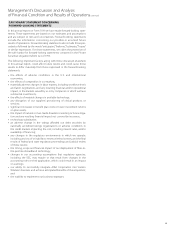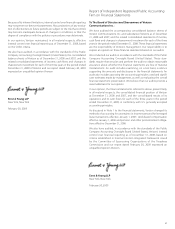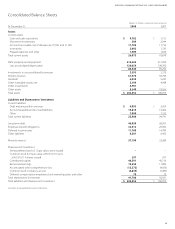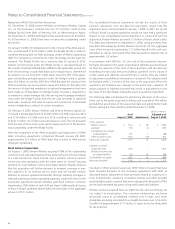Verizon Wireless 2008 Annual Report Download - page 46
Download and view the complete annual report
Please find page 46 of the 2008 Verizon Wireless annual report below. You can navigate through the pages in the report by either clicking on the pages listed below, or by using the keyword search tool below to find specific information within the annual report.Notes to Consolidated Financial Statements continued
44
Interest expense incurred while qualifying wireless licenses are developed
for service is capitalized as part of Wireless licenses. The capitalization
period ends when the development is completed and the licenses are
placed in commercial service.
Intangible Assets Subject to Amortization
Our intangible assets that do not have indefinite lives (primarily customer
lists and non-network internal-use software) are amortized over their
useful lives and reviewed for impairment in accordance with SFAS No.
144, Accounting for the Impairment or Disposal of Long-Lived Assets (SFAS
No. 144), whenever events or changes in circumstances indicate that the
carrying amount of the asset may not be recoverable. If any indications
were present, we would test for recoverability by comparing the carrying
amount of the asset to the net undiscounted cash flows expected to be
generated from the asset. If those net undiscounted cash flows do not
exceed the carrying amount (i.e., the asset is not recoverable), we would
perform the next step, which is to determine the fair value of the asset
and record an impairment, if any. We reevaluate the useful life determi-
nations for these intangible assets each reporting period to determine
whether events and circumstances warrant a revision in their remaining
useful lives.
For information related to the carrying amount of goodwill by segment,
wireless licenses and other intangible assets, as well as the major com-
ponents and average useful lives of our other acquired intangible assets,
see Note 4.
Fair Value Measurements
In September 2006, the FASB issued SFAS No. 157, Fair Value Measurements
(SFAS No. 157). SFAS No. 157 defines fair value, establishes a framework
for measuring fair value and establishes a hierarchy that categorizes and
prioritizes the sources to be used to estimate fair value. SFAS No. 157 also
expands financial statement disclosures about fair value measurements.
Under SFAS No. 157, fair value is defined as an exit price, representing
the amount that would be received to sell an asset or paid to transfer a
liability in an orderly transaction between market participants. SFAS No.
157 also establishes a three-tier hierarchy for inputs used in measuring
fair value, which prioritizes the inputs used in the valuation methodolo-
gies in measuring fair value:
Level 1 – Quoted prices in active markets for identical assets
or liabilities
Level 2 – Observable inputs other than quoted prices in active markets
for identical assets and liabilities
Level 3 – No observable pricing inputs in the market
Financial assets and financial liabilities are classified in their entirety
based on the lowest level of input that is significant to the fair value
measurements. Our assessment of the significance of a particular input
to the fair value measurements requires judgment, and may affect the
valuation of the assets and liabilities being measured and their place-
ment within the fair value hierarchy.
Computer Software Costs
We capitalize the cost of internal-use network and non-network software
which has a useful life in excess of one year. Subsequent additions, modi-
fications or upgrades to internal-use network and non-network software
are capitalized only to the extent that they allow the software to perform
a task it previously did not perform. Software maintenance and training
costs are expensed in the period in which they are incurred. Also, we
capitalize interest associated with the development of internal-use
network and non-network software. Capitalized non-network internal-
use software costs are amortized using the straight-line method over
a period of 2 to 7 years and are included in Other intangible assets, net
in our consolidated balance sheets. For a discussion of our impairment
policy for capitalized software costs, see “Goodwill and Other Intangible
Assets” below. Also, see Note 4 for additional detail of internal-use non-
network software reflected in our consolidated balance sheets.
Goodwill and Other Intangible Assets
Goodwill
Goodwill is the excess of the acquisition cost of businesses over the
fair value of the identifiable net assets acquired. Impairment testing
for goodwill is performed annually or more frequently if indications
of potential impairment exist under the provisions of SFAS No. 142,
Goodwill and Other Intangible Assets (SFAS No. 142). The impairment
test for goodwill uses a two-step approach, which is performed at the
reporting unit level. We have determined that in our case, the reporting
units are our operating segments since that is the lowest level at which
discrete, reliable financial and cash flow information is available. Step
one compares the fair value of the reporting unit (calculated using a
market approach and a discounted cash flow method) to its carrying
value. If the carrying value exceeds the fair value, there is a potential
impairment and step two must be performed. Step two compares the
carrying value of the reporting unit’s goodwill to its implied fair value
(i.e., fair value of reporting unit less the fair value of the unit’s assets
and liabilities, including identifiable intangible assets). If the fair value of
goodwill is less than the carrying amount of goodwill, an impairment
is recognized.
Intangible Assets Not Subject to Amortization
A significant portion of our intangible assets are wireless licenses that
provide our wireless operations with the exclusive right to utilize des-
ignated radio frequency spectrum to provide cellular communication
services. While licenses are issued for only a fixed time, generally ten years,
such licenses are subject to renewal by the Federal Communications
Commission (FCC). Renewals of licenses have occurred routinely and at
nominal cost. Moreover, we have determined that there are currently
no legal, regulatory, contractual, competitive, economic or other factors
that limit the useful life of our wireless licenses. As a result, we treat the
wireless licenses as an indefinite-lived intangible asset under the provi-
sions of SFAS No. 142. We reevaluate the useful life determination for
wireless licenses each reporting period to determine whether events
and circumstances continue to support an indefinite useful life.
We test our wireless licenses for potential impairment annually or more
frequently if indications of impairment exist. We evaluate our licenses
on an aggregate basis using a direct value approach. The direct value
approach determines fair value using estimates of future cash flows
associated specifically with the licenses. If the fair value of the aggre-
gated wireless licenses is less than the aggregated carrying amount of
the licenses, an impairment is recognized.
























